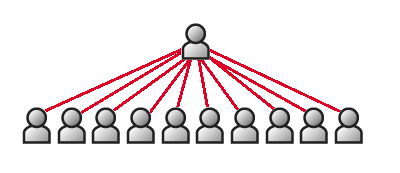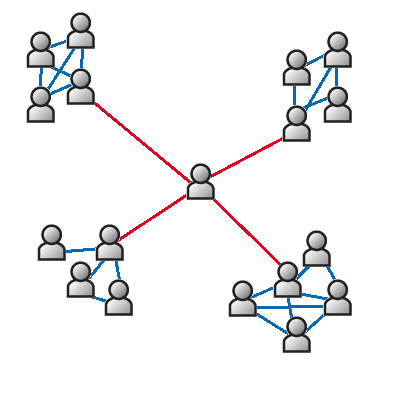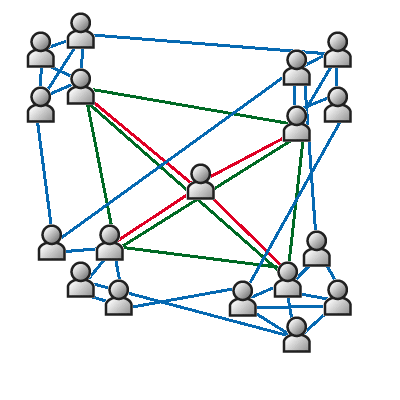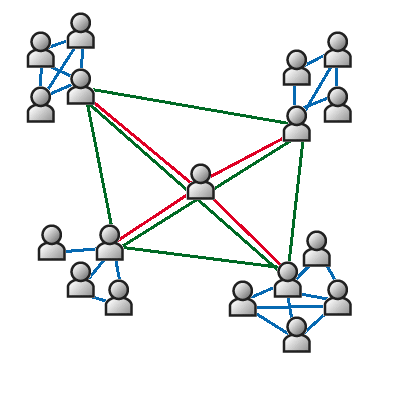teams
There's going to be nothing groundbreaking in here. Just some very basic thinking.
The ideal structure for a company seems to be something like this:

The leader leads a small pack of independent-thinking people to a single goal. This is the dream for all "agile" companies. The benefits to this approach? True equality, a true forum for discussions, and the ability to quickly adapt. The problem with this approach is if you have one bad apple, it really brings everybody else down.
The other downside is this doensn't scale. The next approach seems to be something like this:

A leader communicates with a small cadre of individuals, who then relay the message onto their respective teams. The upsides to this approach: still relatively agile (Depending on the cadre of "inner" team members, this could be more agile, as the decision making of the leader is effectively multiplied), lowers burden of management on the core leader, and leaves specialized teams to execute to their specialty with clear ownership. This structure also has the benefit of "smoothing" over the weaknesses of individual team members. In the first case, the shortcomings of an individual are bared for all to see, in this scenario, a team leader can fill his team with mediocre players and still come out relatively ahead if they're a rockstar manager (see Rands).
Of course, cross functional communcation is important; oftentimes the inner cadre have their own communication channels:
This allows team leaders to strategize, and leave the tactical decisions to their teams. Team leaders can tap the experiences of other team leaders to synchronize activites. Be wary of making both strategic and tactical decisions, cause you're basically treating everybody like mules in that case, and what you really want is Henry Ford's approach to industry, which seems rather ludicrous in an information age.
Upsides to this approach? Still quite agile, still keeps single people in charge of driving the direction of the boat, and still leaves ownership of projects intact. The downsides? It breeds a "I'm a _____, and I'm not in charge of _____" mentality. Unless the connection between all teams is incredibly strong, this will lead to significant problems. For example, it'd be like two people building a bridge across a river from opposite sides; without good communication, you may end up with two pieces which never connect. Oops.
But what about this?

This is close to a "unified" company diagram as I could draw. Everybody communicates openly once the strategy has been laid down to accomplish a task. People perform cross-functional tasks to complete each project at hand. Everybody can tap any other resource at any time. Need marketing resources? Go for it.
The problem with this approach: "Success has many fathers, but failures have none." Be prepared to watch everybody disown themselves from a failed project. Miscommunications are amplifed significantly in this scenario as well. If the central strategic message is articulated strongly, then the risks of people working on non-critical tasks are lessened; otherwise, be prepared to be fighting tons of pet projects that seem strategic, but really aren't. It's very easy to get caught up in with the little things in a scenario like that - one person can effectively lure a bunch of people into working on a non-essential project, which gets harder to kill.
As a manager, this is a tough situation to resolve - you need to understand what your team is working so you can schedule accordingly. For a company that is working towards one goal, this absolutely seems to be the case. What I find helps in scenarios like the third is to have individual team members come up with their work items over a short period of time, and touch base to make sure their work items are inline with what you expect.
This is opposed to approach #2, where the team leaders would articulate the message, and work together on the tactical approach to achieve said goal with their teams. Input in the third scneario can come from many different directions, so the best you can really do is make sure the work being assigned and done fits your objectives (which should align with the corporate objectives).
Through this exercise, I'm trying to figure out the balance between where work items should bubble from - bottom or top. In all scenarios, it's critically important that a core strategy be articulated - this sets the framework for all the thinking. Good communication is an execution multiplier.
Which graph most resembles your work place? Which one seems to work best? I've gone thorugh all three at MindTouch, and am still on the fence. (We're currently at Stage 3, but I'm seeing a lot of problems with it - it's great for executing multiple small projects, but absolutely horrid at executing on strategic big-picture ideas).


Comment with Facebook
Want to comment with Tabulas?. Please login.
hapy
roy

greenlife

SuperSunJ

A large part of the problem with many of these interconnected ones is how they scale, particularly for larger and more complex projects. Also comes the issue of who owns which pieces, turf wars, authorizations, configuration control, etc.
I know in my own company, and in many other companies, I have a dual chain of command: one that flows up through the project and business unit and the other through my functional. This creates interesting tensions as well depend on how it plays out.
roy
